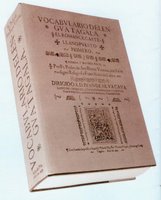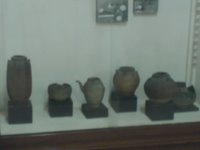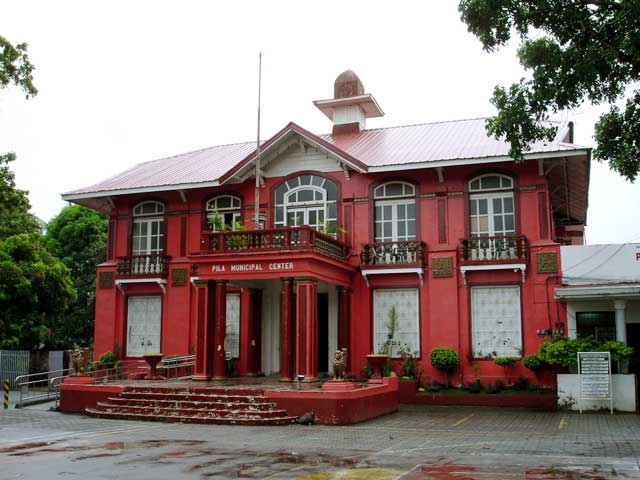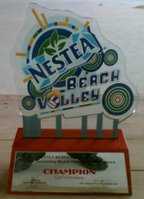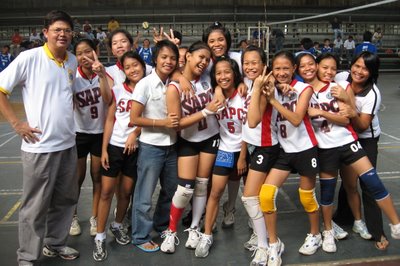By Jaime F. Tiongson
This author wrote an e-mail to Antoon Postma and suggested that Pailah in the Laguna Copperplate Inscription is Pila, Laguna. In his reply, Antoon Postma (2005) wrote that “ai” in Pailah or Payla is a dipthong and can not develop into Pila as suggested. The list below shows that the Tagalog dipthong /ai/ can develop into /i/ or /e/ in disagreement to what he has stated. The following are examples of such development:
- Baynat (SB, 1613 page 116) to Binat (UP, 2001, page 121)
- Saynat (SB, 1613 page 367) to Sinat (UP, 2001, page 787)
- Taynga (SB, 1613, page 458) to Tenga
- Baywang (SB, 1613, page 617) to Bewang (UP, 2001, page 116)
- Mayroon to Meron (UP, 2001, page 553)
- Kailan (SB, 1613, page 60) to Kelan
- Bayki to Beke (UP, 2001, page 111)
- Kaysa to Kesa (UP, 2001, page 442)
Before the arrival of the Spaniards, Tagalog had only three vowel phonemes: /a/, /i/, and /u/. The list was later expanded to five vowels with the introduction of Spanish words. In Tagalog phonology, the dipthong /aI/ can also be pronounced [e~E~eI] and /e/ can sometimes be pronounced as [i~I] thus the development of Pailah to Pila and the rest of the words above.
Laguna Copperplate Inscription bears the date 900 A.D. (Postma, 1992). The Laguna Copperplate Inscription was written during the Emergent Filipino Period [1 to 1500 A.D.(Jocano, 1998) or 500 to 1521 A.D. (Solheim, 2002)]. Jocano (1998) defines this period as the appearance of definable political, economic, and religious organization and certain dominant patterns of culture such as burial practices, ceramic art, and social statuses. The placenames in the Laguna Copperplate Inscription namely: Tundun, Puliran, Pailah and Binwangan are the leading centers of trade, commerce as well as governance of the whole region (Francisco, 1995)
According to Wilhelm G. Solheim II (2002), there are three such concentrations of population known archaeologically to have been in place before A.D. 1000 here in the Philippines. The three emergent Filipino Period areas are Butuan, an area on the shore of Laguna de Bay and an area on the shore of Lake Taal.
In 1967, a team from the University of San Carlos and Locsin group led by Dr. Rosa C.P. Tenazas conducted another archaeological study in Pinagbayanan, Pila, Laguna. The team uncovered Iron Age burials. Tenazas (n.d.) wrote in her report: “The presence of earthenware pots quite different from those encountered in the Sung levels in size and form, as well as in decoration, set them off as a distinct cultural horizon.” She further wrote: “Due to the fact that pots had no association with export ceramics, they tentatively have been attributed an Iron Age date. The burial locations not too far below if not on the same level as the lowest Sung burials, would put it just prior to trade contacts with China near the end of the first millennium A.D. or a little earlier.” The team of Tenazas also uncovered Philippines’ oldest horse bones and crematorium.
In the same year, the Esso-Elizalde archaeological team supervised by Dr. Robert Fox and Mr. Avelino Legaspi of the Anthropology Division of the National Museum conducted excavations in Pinagbayanan and Bagong Pook, Pila. The team recovered 12th to 15th century trade potteries (Valdes, 2003).
The series of archaeological studies and vast amount of trade potteries recovered in Pila, Laguna led scientists and archaeologists to conclude that Pila, Laguna is an important pre-hispanic center of culture and trade. The scientific conclusion became one of the bases for declaring the town of Pila, Laguna a National Historical Landmark[1].
Historian Dr. Luciano Santiago (1997) wrote that “some scholars believe that the copper plate inscription refers instead to barangays in Bulacan Province rather than in Laguna. However, the places referred to in Bulacan are nowhere as significant in Philippine prehistory as those in Laguna”. The Postma suggested Paila site which is located in San Lorenzo, Norzagaray, Bulacan is not even listed as one of the barangays of the said town. The town of Norzagaray was named after General Fernand de Norzagaray y Escudero, Govenor General of the Philippines from 1857-1860. Barrios Casay, Lawang, Tigbi and Bayabas of Angat were formed into the town of Norzagaray during his governorship. (Erecciones, 1764 -1890).
Postma (1992) defines Pulilan as the area along the south east Laguna de Bay area which includes Pila. He further wrote that Pila is within the area of Pulilan and LCI clearly indicates two separate localities with each own leader. This is the reason why he chose instead Pulilan, Bulacan and Paila, San Lorenzo, Norzagaray, Bulacan. This author already explained previously that Pulilan is not the south east area of Laguna de Bay but the Laguna de Bay itself and Puliran Kasumuran[2] is the Laguna de Bay water source. The Puliran Kasumuran region includes present town of Nagcarlan, Liliw, Mahayhay, Lucban, Tayabas and distinctly separate from Pila, Laguna
If Kasumuran is the source of water of Pulilan, Bulacan (Angat and surrounding communities including Norzagaray), the Paila of San Lorenzo, Norzagaray is within the Kasumuran region of Pulilan, Bulacan. Using the same argument raised by Postma above then Paila in Norzagaray is not the Pailah in the Laguna Copperplate Inscription.____________________
[1]The National Historical Institute of the Philippines declared the town plaza and surrounding ancestral houses a National Historical Landmark on May 17, 2000. Sources:
Almario, Virgilio S. ed. 2001. UP Diksiyonaryong Filipino. Pasig City.
Ereccion del Pueblos-Bulacan, 1764-1890. Paper creating the barrios Casay, Lawang, Tigbi and Bayabas into new town named Norzagaray, apart from Angat. Bundle no. 45, Legajo no. 129.
Francisco, Juan R. 1995. “Tenth Century Trade/Settlement Area In South East Asia: Epigraphic and Language Evidence in the Philippines,” National Museum Papers: Vol. 4, No.2:10-35.
Jocano, Landa F. 1998. Filipino Prehistory. Quezon City.
Kuang-Jen Chang, “A Comparative study of trade ceramics as grave goods in Pila, Laguna and Calatagan, Batangas, SW Luzon, the Philippines,” presented at Congres International, European Association of Southeast Asian Archaeologists, 11th International Conference, Bougon, France, 2006.
Postma, Antoon. 1992. “The Laguna Copperplate Inscription,” Philippine Studies 40:183-203.
Postma, Antoon, <mangyanhc@catsi.net.ph> “Reply to letter for Mr. Antoon Postma from the Pila Historical Society Foundation Inc”, Personal Email (11 November 2005)
San Antonio, Francisco de. 2000. Vocabulario Tagalo. Tagalog-Spanish Dictionary. Quezon City.
San Buenaventura, Pedro de. 1613. Vocabulario de Lengua Tagala. Pila.
Santiago, Luciano P.R. 1997. “The Roots Of Pila, Laguna, A Secular And Spiritual History Of The Town (900 AD To The Present),” Philippine quarterly of culture and society 25:125-155.
Solheim, Wilhelm G. 2002. The Archeology of Central Philippines. A study c hiefly of the iron age and its relationships. Revised Ed. Quezon City.
Tenazas, Rosa C.P. n.d. A Report on the Archeology of the Locsin-University of San Carlos Excavations in Pila, Laguna (September 4, 1967 – March 19, 1968). privately printed.
Tiongson, Jaime F. The Laguna Copperplate Inscription and the Route to Paracale in “Heritage and Vigilance: The Pila Historical Society Foundation Inc. Programs for the Study and Preservation of National Historical Landmarks and Treasures,” presented at Seminar on Philippine Town and Cities: Reflections of the Past, Lessons for the Future, Pasig City, 2006.
Tiongson, Jaime F. 2004. The Paracale Gold Route. Unpublished Manuscript. Cited in Santiago, Luciano P.R. 2005. “Pomp, Pageantry and Gold: The Eight Spanish Villas in the Philippines (1565-1887),” Philippine Quarterly of Culture and Society: 33:57-75.
Valdes, Cynthia O. “Archaeology in the Philippines, the National Museum and an Emergent Filipino Nation,” Wilhelm G. Solheim II Foundation for Philippine Archaelogy, Inc. 25 Feb 2004. http://homepages.uni-tuebingen.de/alfred.pawlik/Solheim/philippine_archaeology.html
________. 2003. “Pila in Ancient Time,” in Treasures of Pila. pp 3-6.
 The 1835 copy of the Vocabulario de la Lengua Tagala by Fr. Domingo de los Santos O.F.M. was offered for sale at eBay last September. Staring bid was pegged at $3,999.00. No bids were received till September 19, 2006 closing.
The 1835 copy of the Vocabulario de la Lengua Tagala by Fr. Domingo de los Santos O.F.M. was offered for sale at eBay last September. Staring bid was pegged at $3,999.00. No bids were received till September 19, 2006 closing.
